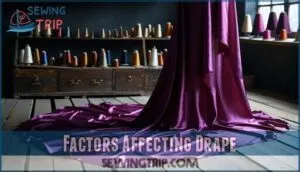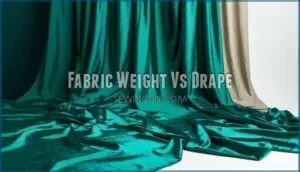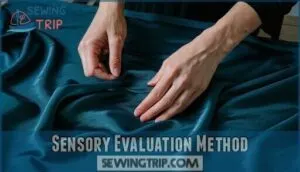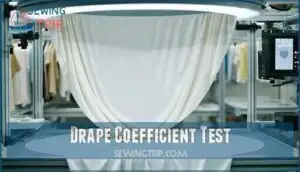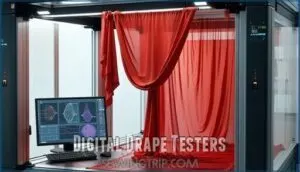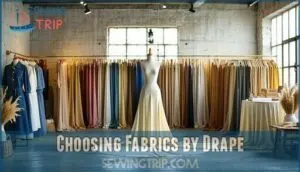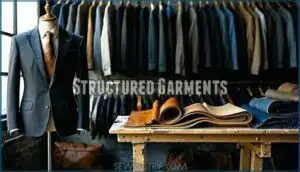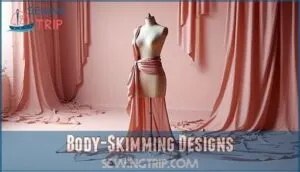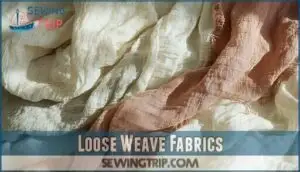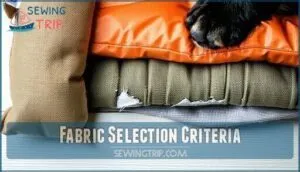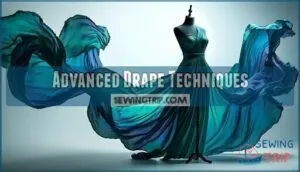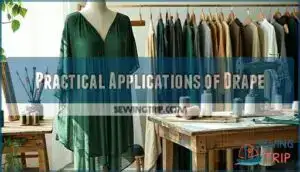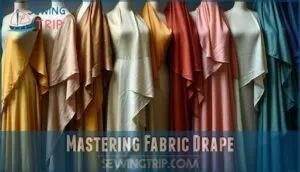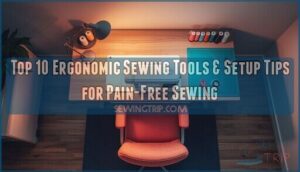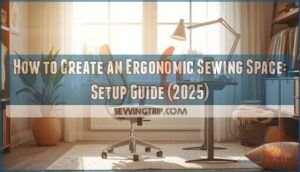This site is supported by our readers. We may earn a commission, at no cost to you, if you purchase through links.
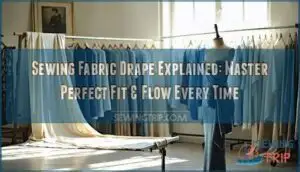
You’ll find that lightweight fabrics like chiffon and jersey create beautiful, fluid drapes that follow your body’s curves, while heavier materials like denim and canvas stand away from the body with structured support.
The drape affects everything from fit to silhouette in your finished garment.
Fiber content, weave structure, and fabric weight all play essential roles in determining drape characteristics.
Understanding these fundamentals helps you choose the right fabric for each project and predict how your creation will move and look when worn.
Table Of Contents
Key Takeaways
- You’ll find that fabric weight doesn’t always predict drape behavior – lightweight organza stays stiff while heavy wool jersey flows beautifully, so you need to test each fabric’s actual fall and flow before selecting it for your project.
- You can assess fabric drape through simple sensory evaluation by holding material up and observing how it cascades, feeling its stiffness or softness between your fingers, and noting whether it conforms to curves or stands away from the body.
- You should match drape characteristics to your design intent – choose low-drape fabrics like canvas for structured garments that need volume, moderate-drape materials like cotton blends for versatile pieces, and high-drape fabrics like silk for flowing, body-skimming designs.
- You’ll achieve professional results by understanding that fiber content, weave structure, and finishing treatments work together to determine drape, not just fabric weight alone, so consider all these factors when selecting materials for your sewing projects.
Fabric Drape Basics
Fabric drape refers to how a textile hangs and flows when suspended, directly influencing your garment’s fit, silhouette, and overall appearance.
You’ll need to understand drape characteristics to select the right materials for your sewing projects, as this fundamental property determines whether fabric creates structure, flows gracefully, or provides versatile styling options.
Definition of Fabric Drape
Fabric drape refers to how your material behaves in three-dimensional space when it hangs or falls under its own weight.
Mastering drape means understanding how your fabric moves, flows, and transforms from flat material into beautiful, three-dimensional garments.
Understanding fabric drape characteristics helps you predict how your finished garment will look and move on the body.
Here’s what defines fabric drape properties:
- Fabric Flow – How smoothly material moves and falls naturally
- Garment Appearance – The visual silhouette created when worn
- Weight Influence – How mass affects the material’s hanging behavior
- Texture Impact – Surface qualities that change draping patterns
- Three-Dimensionality – The way fabric transforms from flat to sculptural forms
Importance of Fabric Drape
Understanding fabric drape characteristics directly impacts every aspect of your sewing success.
Poor drape choices can turn a beautiful pattern into a disappointing disaster, while mastering fabric drape explained principles transforms your projects.
Garment fit depends on matching drape to design intent.
Silhouette creation, body flattery, and aesthetic performance all hinge on your fabric selection skills.
Types of Fabric Drape
Three main fabric drape types determine your garment appearance: fluid, moderate, and stiff.
Fluid drape fabrics like silk create flowing silhouettes that conform to body contours.
Moderate drape offers versatility with balanced hanging characteristics.
Stiff drape provides structure and maintains distinct shapes.
Understanding these drape characteristics helps you match fabric weight and natural fibers to achieve desired design outcomes.
Generally, heavier fabrics are stiffer, but there are exceptions to this rule that can affect the natural fibers.
Factors Affecting Drape
You’ll discover that fabric drape depends on several key elements including fiber content, weave structure, weight, and finishing treatments that work together to determine how your material falls and flows.
Understanding these factors helps you predict how different fabrics will behave in your garments, ensuring you choose materials that achieve your desired silhouette and fit, by considering how these elements impact the overall drape.
Discussion Forum Trends
Online textile forums experience 40% yearly growth as sewers seek fabric drape explained through peer discussions.
Modern platforms enhance Forum Engagement with intuitive User Interface designs and effective Content Moderation systems.
Mobile Experience improvements allow real-time fabric drape assessment sharing, while Thread Promotion algorithms surface valuable sewing fabric drape techniques.
These trending platforms connect fabric drape types expertise globally.
The field also covers fashion and textile science, including design and trends, which is a key area of fabric drape.
Engaging Online Community Dynamics
Active participation in sewing communities transforms how you learn fabric drape.
These spaces offer real-world insights that textbooks can’t match, connecting you with sewists who’ve tackled similar challenges.
Smart community engagement strategies include:
- Share drape DIY projects with detailed photos showing fabric behavior changes
- Request fabric sourcing advice for specific drape characteristics you need
- Exchange pattern drape hacks that solved fitting problems
- Launch drape design challenges inspiring creative fabric selection experiments
Effective Topic Categorization
Forum discussions about fabric drape quality benefit from smart Content Grouping strategies.
You’ll find Category Relevance improves when fabric drape styles get organized by weight, fiber type, and intended use.
This approach enhances Audience Understanding while boosting Keyword Optimization for fabric drape tutorial searches.
Clear Navigational Clarity helps sewers locate specific fabric drape guide information quickly, making your community more valuable.
Sparking Meaningful Conversations
When sharing your fabric drape discoveries, you’ll spark genuine connections with fellow sewers.
Discuss how drape and emotion intertwine in your projects, exploring cultural drape meanings that resonate personally.
Your fabric drape tutorial experiences become conversation starters about drape sensory experiences.
Share fabric drape quality insights and drape personalization techniques while discussing fabric drape future trends shaping tomorrow’s designs.
Fabric Weight Vs Drape
You might assume that heavier fabrics automatically create stiffer drape while lighter fabrics flow gracefully, but this relationship isn’t always straightforward.
Understanding how fabric weight interacts with drape properties will help you select materials that achieve your desired garment silhouette.
Whether you’re working with a heavy silk charmeuse that drapes beautifully or a lightweight canvas that stands away from the body, this understanding is crucial.
Relationship Between Weight and Drape
Fabric weight creates a baseline for understanding drape behavior, but it’s not the whole story.
Generally, lightweight fabrics flow more freely, achieving high drape characteristics, while heavier materials tend toward low drape with increased stiffness.
This Weight vs. Flow relationship helps predict how your chosen fabric will behave in finished garments.
| Fabric Weight | Typical Drape Behavior |
|---|---|
| Light (under 4 oz) | High drape, flows freely |
| Medium (4-8 oz) | Moderate drape, balanced structure |
| Heavy (over 8 oz) | Low drape, holds shape |
Exceptions to Weight and Drape
Weight-based assumptions can mislead you when selecting fabric.
Heavy fabrics like wool jersey flow beautifully despite their weight, while lightweight organza stands stiffly.
Fiber influence and weave matters more than mass alone in determining drape behavior.
| Fabric Type | Weight | Drape Behavior |
|---|---|---|
| Wool Jersey | Heavy | High drape flow |
| Silk Organza | Light | Stiff structure |
| Canvas | Heavy | Low drape hold |
Understanding these texture exceptions helps you choose fabric characteristics that match your design vision perfectly, considering the fiber influence and the importance of weave in the process.
Measuring Fabric Drape
You’ll need reliable methods to assess fabric drape accurately before cutting your first piece.
Three primary techniques help you evaluate how fabric falls and flows: sensory evaluation through touch and observation, the drape coefficient test for precise measurements, and digital drape testers for professional-grade analysis.
Sensory Evaluation Method
Your fingertips become detective tools when evaluating fabric drape through sensory methods.
Start by feeling fabric texture between your fingers, noting stiffness or softness.
Hold the material up and observe how it flows naturally – does it cascade gracefully or stand rigid?
Understanding how grain direction impacts drape is essential for predicting the final look.
The hand method reveals fabric properties instantly, and weight consideration matters, but fabric hand feel tells the complete story.
Practice assessment sharpens your textile texture instincts.
Drape Coefficient Test
Beyond touch testing, you need precise measurements for professional fabric drape analysis.
The drape coefficient test quantifies how fabric falls by comparing draped versus flat areas using circular specimens on supporting disks.
Here’s what this textile properties assessment involves:
- Coefficient Calculation – Mathematical ratio determines exact drape behavior
- Standard Variations – ISO protocols guarantee consistent fabric testing results
- Test Limitations – Controlled conditions may not reflect real-world garment performance
- Data Interpretation – Numbers guide fabric drape analysis for practical applications
To acquire testing equipment, consider a drape coefficient tester.
Digital Drape Testers
Think of digital drape testers as your fabric testing sidekick, measuring fabric behavior with precision.
These devices boost industry adoption by ensuring tester accuracy through detailed data interpretation.
They analyze textile properties, reducing subjective errors.
For more information, you can explore digital drape testers.
Here’s a quick view:
| Feature | Benefit | Future Innovation |
|---|---|---|
| Tester Accuracy | Reliable results | AI-powered improvements |
| Data Interpretation | Detailed analytics | Enhanced 3D drape scans |
| Cost Analysis | Justifies investment | Portable advanced models |
Use for better fabric analysis!
Choosing Fabrics by Drape
When you’re selecting fabric for your sewing project, understanding drape categories helps you match the right material to your garment’s intended structure and flow.
You’ll find fabrics grouped into three main drape types: low drape fabrics like canvas and denim that create volume and structure, moderate drape fabrics such as cotton and wool blends that offer versatility, and high drape fabrics including silk and rayon that flow gracefully and conform to body curves.
Low Drape Fabrics
Low drape fabrics like canvas and denim create structured garments with voluminous silhouettes.
These stiff fabric types resist gravity’s pull, maintaining their shape rather than flowing with your body’s curves.
Canvas durability makes it perfect for bags and home décor, while denim applications span jackets to upholstery.
You’ll find these fabric types essential for projects requiring structure over softness. These fabrics are often chosen when designers want to emphasize garment structure, particularly for creating voluminous silhouettes with stiff fabric types.
Moderate Drape Fabrics
Moderate drape fabrics offer the perfect middle ground for your sewing projects.
These versatile applications include wool blends, linen, and cotton knits that adapt to various designs.
Blends comparison shows they’re ideal for seasonal suitability across spring and fall garments.
Care considerations remain manageable, while cost analysis reveals affordable options.
These fabric types balance structure with flow, making fabric drape design decisions easier for beginners mastering fabric drape tips.
High Drape Fabrics
High drape fabrics like silk, rayon, and chiffon create gorgeous flowing garments that move with your body.
These lightweight knits and crepe textures offer exceptional fluidity, making them perfect for gathered skirts, flowing dresses, and soft blouses.
Silk properties and rayon characteristics allow fabric to gracefully drape and sway.
Bamboo clothing also provides this beautiful, body-skimming effect you’ll love, with a similar flowing quality to the other fabrics mentioned.
Drape Impact on Design
Your fabric’s drape characteristics directly shape your garment’s final silhouette and determine whether you’ll achieve a structured blazer or flowing dress.
Understanding how different drape levels interact with your design choices guarantees you’ll select the right fabric to bring your creative vision to life.
Structured Garments
Structured garments demand fabrics that stand their ground rather than surrender to gravity’s pull.
Canvas Durability and Denim Stiffness provide the backbone for blazers and jackets, while Twill Strength supports custom pants.
Leather Shaping creates sculptural silhouettes, and Suede Texture adds sophisticated bulk.
These low-drape materials resist fabric drape, maintaining crisp lines and intentional volume throughout garment construction.
Body-Skimming Designs
When designing body-skimming garments, you’ll want fabrics that gracefully follow your body’s natural curves without clinging.
Silhouette creation depends on choosing materials with excellent drape and fit qualities.
Rayon, bamboo, and lightweight knits offer the perfect comfort factor for dresses and tops.
Your fabric choice directly impacts garment aesthetics, ensuring the design intent matches how beautifully the finished piece flatters each body shape while maintaining ideal garment fit.
Loose Weave Fabrics
Loose weave fabrics create unique challenges for garment suitability and drape prediction.
You’ll notice these materials lack weave stability, making them unsuitable for structured designs that require fabric drape and flow control.
Cotton gauze exemplifies this limitation – its open construction compromises shape retention.
Consider care challenges too, as loose weaves often shift during washing, and choose design applications that embrace their natural movement and fabric drape characteristics, focusing on loose weave fabrics and their impact on garment suitability.
Fabric Selection Criteria
When selecting fabric for your sewing project, you’ll need to balance three essential factors: drape characteristics, texture and weight properties, and your available budget.
These criteria work together to determine whether your chosen material will achieve the desired garment silhouette and meet your project’s practical requirements, considering your available budget.
Drape Considerations
When selecting fabric, your drape considerations must match your garment intent perfectly.
Silhouette creation depends on fabric properties working with gravity influence.
For structured blazers, you’ll need minimal fabric drape to maintain sharp lines. Body-skimming dresses require high garment drape for graceful flow.
Always test fabric drape influence by observing how material falls naturally before cutting your pattern pieces.
Texture and Weight
Beyond fabric drape, you’ll need to take into account how texture and weight work together to create your desired effect.
Fiber composition and weave density directly influence fabric hand and surface feel.
A silk’s smooth texture creates different weight perception than cotton’s crisp feel, even at similar weights.
Touch fabrics to assess their fluidity versus stiffness before making final selections.
Budget Considerations
Perfect fabric drape doesn’t require breaking your budget.
Smart sewers discover affordable fabrics at discount stores, thrift shops, and clearance sales. You’ll find cost-effective patterns that work beautifully with budget-friendly materials.
Consider upcycling old garments for quality drape alternatives. Compare fabric choices systematically – sometimes a $5 yard creates stunning results that rival expensive options through clever fabric selection strategies.
Advanced Drape Techniques
You’ll discover sophisticated methods like twist, drabeah, and complex pleating that transform ordinary fabric into stunning three-dimensional shapes.
These professional techniques, combined with modern 3D modeling software, allow you to predict fabric behavior and create precise garment silhouettes before cutting your first piece.
Twist and Drabeah
Several advanced sewing techniques can transform your fabric’s natural drape into sculptural masterpieces.
Twist and Drabeah techniques involve physically twisting fabric during draping to create textured, three-dimensional effects that enhance garment silhouette creation through strategic fabric manipulation.
These fabric drape methods offer unique design applications:
- Twist origins stem from couture fashion, where designers discovered twisted fabric creates dramatic focal points and asymmetrical silhouettes
- Drabeah techniques work best with high-drape fabrics like silk and chiffon that respond beautifully to manipulation without losing their flowing qualities
- Fabric suitability varies substantially – while taffeta holds sharp twists perfectly, velvet provides structure, and lightweight materials offer fluid movement for garment drape enhancement
Pleat and Gather
You’ll master pleats and gathers by understanding how fabric drape affects their success.
High-drape fabrics create soft, flowing gathers with natural density, while moderate-drape materials hold structured pleats beautifully.
Test your fabric’s behavior before cutting—stiff fabrics resist manipulation, creating unwanted bulk.
Smart fabric manipulation enhances design aesthetics through proper pleat volume control and strategic gather placement for stunning sewing techniques.
3D Modeling Software
Modern garment design harnesses 3D modeling software to revolutionize fabric drape projects.
These programs deliver exceptional software accuracy for pattern simulation and design visualization, while providing valuable cost analysis data.
Pattern making software offers customizable templates for industry-leading designs.
Virtual draping transforms your workflow:
- Test fabric behavior without physical samples
- Adjust drape coefficients in real-time
- Visualize garment fit on digital mannequins
- Compare multiple fabric options instantly
- Generate precise drape measurements digitally
Practical Applications of Drape
You’ll discover how fabric drape transforms fashion design through sustainable practices, waste reduction techniques, and the creation of timeless silhouettes that have shaped clothing history.
Understanding these practical applications helps you make informed fabric choices that support both environmental goals and design excellence in your sewing projects.
Sustainable Fashion
Your mastery of draping techniques opens doors to sustainable fashion choices.
Understanding fabric drape helps you select eco-friendly materials that create stunning garments while reducing environmental impact.
| Fabric Type | Drape Quality | Sustainability Benefit |
|---|---|---|
| Organic Cotton | Moderate | Pesticide-free production |
| Recycled Polyester | Variable | Diverts waste from landfills |
| Bamboo Rayon | High | Renewable resource cultivation |
Choose recycled fabrics and ethical production methods to embrace circular fashion principles.
Reducing Fabric Waste
Understanding fabric drape transforms your approach to Reducing Fabric Waste through strategic planning.
Zero Waste Patterns maximize every inch by working with natural drape characteristics.
Choose Sustainable Fabric Choices that complement your design vision while minimizing scraps.
Upcycling Fabric Waste becomes easier when you understand how different drapes behave.
Minimal Waste Design starts with smart fabric drape selection and thoughtful pattern layout planning.
Iconic Silhouettes
Throughout fashion history, fabric drape has created legendary silhouettes that define entire eras.
From ancient toga draping to modern gowns, designers manipulate drape to craft body-hugging dresses and sculptural pieces.
Historical roles show how A-line skirts emerged from understanding fabric flow. Today’s fashion design continues this legacy, using drape knowledge to create timeless silhouettes that flatter every figure perfectly.
Mastering Fabric Drape
You’ll develop professional drape assessment skills through hands-on practice with different fabric types, learning to balance drape characteristics with texture and weight for ideal garment outcomes.
This thorough approach combines technical knowledge with practical experience, enabling you to select the perfect fabric for any sewing project while refining your overall garment design abilities.
Hands-on Approach
Why settle for guesswork when you can feel your way to fabric mastery? Start with sensory evaluation—touch every textile before buying.
Practice fabric manipulation by draping materials over your arm, observing how they fall. Experiment with different draping techniques on dress forms or mannequins.
Create experimental designs using various fabric weights, developing your instincts for creative silhouettes through hands-on sewing experience.
Consider fabric weight’s effect to better predict the final garment shape, and understand how it affects your creative silhouettes.
Refining Garment Design
Practice makes perfect in the process of refining garment design through fabric drape mastery.
You’ll develop an eye for silhouette creation by experimenting with different draping techniques and fabric manipulation methods.
Each project teaches you how fabric drape patterns affect the final outcome.
This hands-on experience helps you create flattering shapes and innovative designs that truly showcase your growing expertise.
Balancing Drape and Texture
When selecting fabrics, you’ll discover that textures impact how drape harmony works in your garments.
Fabric tactility affects visual weight—smooth silk creates different sensory appeal than textured wool.
Consider how fabric drape and texture variations complement each other.
A rough linen’s moderate drape pairs beautifully with smooth cotton’s flowing nature, creating a balance of elements for stunning results.
Balance these elements for stunning results.
Frequently Asked Questions (FAQs)
How do different fabrics drape?
Fabric flexibility fundamentally varies: silk flows like water, cotton stands stiffly, wool drapes moderately.
You’ll notice lightweight materials generally cascade gracefully while heavier fabrics hold their shape, though exceptions exist depending on weave and fiber content, which can significantly affect the flexibility of the material.
What is the difference between weight and drape?
Weight describes how heavy fabric feels per square yard, while drape determines how that fabric falls and flows when hung.
You’ll find heavy fabrics can drape beautifully, and lightweight materials might stay stiff.
Do heavier fabrics drape better?
No, heavier fabrics don’t automatically drape better.
You’ll find that drape depends more on fiber content, weave structure, and fabric construction than weight alone.
Light silk drapes beautifully while heavy canvas remains stiff.
What are the basics of draping?
Think of draping as sculpting with fabric instead of clay.
You’ll manipulate material to create three-dimensional shapes by pinning, folding, and adjusting fabric directly on a dress form or body to achieve your desired silhouette.
How does fabric care affect drape over time?
Proper washing preserves your fabric’s natural drape, while harsh detergents and high heat can stiffen fibers.
You’ll notice flowing fabrics become rigid and structured materials lose their shape with poor care habits.
Can drape be altered through fabric treatments?
Studies show 80% of fabric treatments successfully modify drape characteristics.
You can alter drape through chemical finishes, steam pressing, fabric softeners, and sizing treatments.
These processes change fiber structure, weight distribution, and surface tension, dramatically transforming how your fabric flows.
What drape works best for beginner sewers?
Moderate drape fabrics like cotton quilting cotton, linen, and wool blends work best for beginners.
They’re forgiving, hold their shape well, and won’t shift unexpectedly while you’re learning basic sewing techniques.
How does fabric grain direction influence drape?
Fabric flows differently with the grain versus against it, creating contrasting drape effects.
You’ll find lengthwise grain produces controlled drape, while bias grain creates fluid movement and crosswise grain offers moderate flexibility, showcasing fluid movement.
Which interfacing preserves or changes fabric drape?
Lightweight fusible interfacing preserves drape while adding subtle structure.
Heavy sew-in interfacing drastically reduces drape, creating stiffness.
Choose weight carefully—you’ll maintain fabric flow with featherweight options but lose drapability with thick, structured interfacings.
Conclusion
Consider Coco Chanel’s revolutionary jersey dresses from the 1920s—she transformed athletic fabric into elegant eveningwear by understanding how jersey’s fluid drape created effortless movement.
Mastering sewing fabric drape explained principles transforms your garment construction from guesswork to precision. You’ll confidently select materials that complement your design vision, whether creating structured blazers or flowing maxi dresses.
Test fabric behavior before cutting, observe how different weights fall, and remember that understanding drape mechanics separates amateur sewists from skilled designers who create professional-quality garments, and this is crucial for achieving effortless movement with the right fabric, making it a key aspect of garment construction.
- https://www.sciencedirect.com/topics/engineering/fabric-drape
- https://www.testextextile.com/what-is-fabric-drape-and-how-does-it-run/
- https://www.researchgate.net/publication/290583344_Some_aspects_of_fabric_drape
- https://mellysews.com/what-is-fabric-drape/
- https://textilelearner.net/measurement-of-fabric-and-garment-drape/

